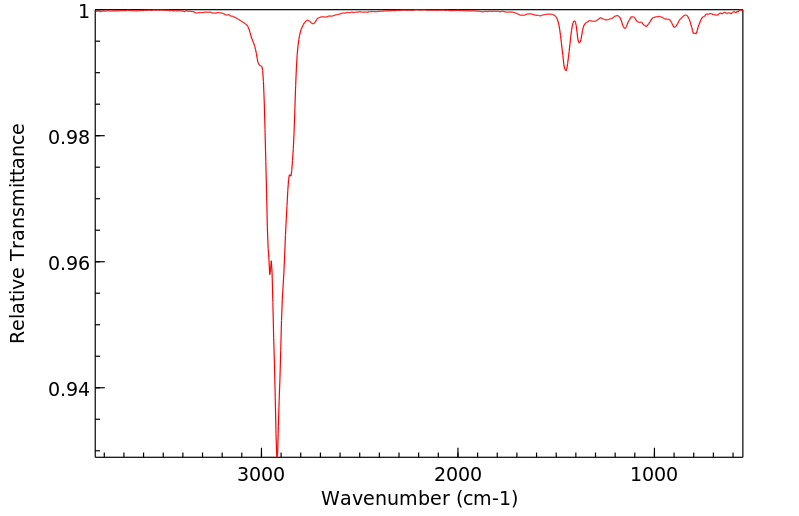1,4-二甲基环己烯 | 2808-79-9
中文名称
1,4-二甲基环己烯
中文别名
——
英文名称
1,4-dimethylcyclohex-1-ene
英文别名
1,4-Dimethyl-cyclohexen;1,4-dimethylcyclohexene;1.4-Dimethyl-cyclohexen-(1);1,4-dimethyl-1-cyclohexene
CAS
2808-79-9
化学式
C8H14
mdl
MFCD00001564
分子量
110.199
InChiKey
KMGDYKOGDOVDCW-UHFFFAOYSA-N
BEILSTEIN
——
EINECS
——
-
物化性质
-
计算性质
-
ADMET
-
安全信息
-
SDS
-
制备方法与用途
-
上下游信息
-
文献信息
-
表征谱图
-
同类化合物
-
相关功能分类
-
相关结构分类
物化性质
-
熔点:-59.4°C
-
沸点:124.85°C
-
密度:0.8005
-
保留指数:825;836;827;817.5;825;825
计算性质
-
辛醇/水分配系数(LogP):2.6
-
重原子数:8
-
可旋转键数:0
-
环数:1.0
-
sp3杂化的碳原子比例:0.75
-
拓扑面积:0
-
氢给体数:0
-
氢受体数:0
SDS
反应信息
-
作为反应物:描述:1,4-二甲基环己烯 在 1,5-hexadienerhodium(I)-chloride dimer 氢气 作用下, 以 various solvent(s) 为溶剂, 反应 9.0h, 以84%的产率得到1,4-二甲基环己烷参考文献:名称:Januszkiewicz, Krzysztof R.; Alper, Howard, Canadian Journal of Chemistry, 1984, vol. 62, p. 1031 - 1033摘要:DOI:
-
作为产物:描述:参考文献:名称:硅胶上吸附的无水氯化铁导致叔环丁醇环扩大:异月桂烯及其衍生物,樟脑醚和(±)铜烯的合成摘要:通过将无水FeCl 3和硅胶混合,在干燥介质中脱水和叔环丁醇的特定C 4 →C 5环扩大,烯烃醇环化和四氢吡喃基醚裂解得到的试剂。DOI:10.1016/s0040-4020(01)96434-8
文献信息
-
Hydrogenation of arenes and N-heteroaromatic compounds over ruthenium nanoparticles on poly(4-vinylpyridine): a versatile catalyst operating by a substrate-dependent dual site mechanism作者:Minfeng Fang、Nataliya Machalaba、Roberto A. Sánchez-DelgadoDOI:10.1039/c1dt10801h日期:——A nanostructured catalyst composed of Ru nanoparticles immobilized on poly(4-vinylpyridine) (PVPy) has been synthesized by NaBH4 reduction of RuCl3·3H2O in the presence of the polymer in methanol at room temperature. TEM measurements show well-dispersed Ru nanoparticles with an average diameter of 3.1 nm. Both powder XRD patterns and XPS data indicate that the Ru particles are predominantly in the zerovalent state. The new catalyst is efficient for the hydrogenation of a wide variety of aromatic hydrocarbons and N-heteroaromatic compounds representative of components of petroleum-derived fuels. The experimental data indicate the existence of two distinct active sites in the nanostructure that lead to two parallel hydrogenation pathways, one for simple aromatics involving conventional homolytic hydrogen splitting on Ru and a second one for N-heteroaromatics taking place via a novel heterolytic hydrogen activation on the catalyst surface, assisted by the basic pyridine groups of the support.
-
Unsaturated Aldehydes as Alkene Equivalents in the Diels–Alder Reaction作者:Esben Taarning、Robert MadsenDOI:10.1002/chem.200800003日期:2008.6.20A one-pot procedure is described for using alpha,beta-unsaturated aldehydes as olefin equivalents in the Diels-Alder reaction. The method combines the normal electron demand cycloaddition with aldehyde dienophiles and the rhodium-catalyzed decarbonylation of aldehydes to afford cyclohexenes with no electron-withdrawing substituents. In this way, the aldehyde group serves as a traceless control element描述了一种一锅法,该方法用于在Diels-Alder反应中使用α,β-不饱和醛作为烯烃当量。该方法将正常的电子需求环加成反应与醛二烯亲和剂和铑催化的醛脱羰反应结合在一起,得到不具有吸电子取代基的环己烯。以这种方式,醛基用作指导环加成反应的无痕控制元素。在催化量的三氟化硼醚化物的存在下,在二甘醇二甲醚溶液中进行Diels-Alder反应。随后路易斯酸的淬灭,添加0.3%的[Rh(dppp)2 Cl]并加热至回流实现了随后的脱羰作用,得到了环己烯产物。在这些条件下,丙烯醛,巴豆醛和肉桂醛已与多种1,3-二烯可提供环己烯的总收率在53%到88%之间。在这些转化中,这三种醛分别相当于乙烯,丙烯和苯乙烯。
-
Pesticidal compounds申请人:The Wellcome Foundation Limited公开号:US05116862A1公开(公告)日:1992-05-26The present invention provides a class of novel substituted bicyclooctanes which have pesticidal activity, particularly against arthropod pests. Pesticidal formulations containing the compounds of the formula (I), their use in the control of pests and methods for their preparation are also disclosed.本发明提供了一类具有杀虫活性的新型取代双环辛烷化合物,特别针对节肢动物害虫。还公开了含有式(I)化合物的杀虫配方,以及它们在害虫控制中的使用方法和制备方法。
-
A New Synthesis of trans-Iodohydrins using Iodine–Cerium(IV) Salts†作者:C. Akira Horiuchi、Akira Ikeda、Miyuki Kanamori、Haruomi Hosokawa,、Takashi Sugiyama、T. Tomoyoshi TakahashiDOI:10.1039/a605548f日期:——The reaction of cycloalkene with iodineâcerium(IV) ammonium nitrate (CAN) in acetonitrileâwater (10:1â1:1) affords the corresponding trans-iodohydrins and trans-iodonitrates; when iodineâcerium(IV) sulfate (CS) in acetonitrileâwater (10:1) at 50 °C is used, trans-iodohydrins are obtained preferentially.
-
Ligand effect in the Rh-NP catalysed partial hydrogenation of substituted arenes作者:Jessica Llop Castelbou、Aitor Gual、Elisabet Mercadé、Carmen Claver、Cyril GodardDOI:10.1039/c3cy00388d日期:——phosphine and phosphite ligands I–IV were synthesised, characterised and applied as catalysts in the partial hydrogenation of substituted arenes. In the case of disubstituted arenes, selectivities for the corresponding cyclohexene derivatives of up to 39% were achieved at ca. 40% conversion. The effect of parameters such as temperature and pressure was also examined. In the hydrogenation of styrene, very
表征谱图
-
氢谱1HNMR
-
质谱MS
-
碳谱13CNMR
-
红外IR
-
拉曼Raman
-
峰位数据
-
峰位匹配
-
表征信息
同类化合物
高密聚乙烯
香叶醇
顺式3-甲基-2-己烯
顺式-5-癸烯
顺式-5-甲基-2-己烯
顺式-5-庚烯-1-炔
顺式-4-癸烷
顺式-4-甲基-2-戊烯
顺式-4-甲基-2-戊烯
顺式-3-癸烯
顺式-3-甲基-3-己烯
顺式-3-甲基-2-庚烯
顺式-3-戊烯-1-炔
顺式-3,4-二甲基-3-己烯
顺式-3,4-二甲基-2-戊烯
顺式-3,4-二甲基-2-戊烯
顺式-2-甲基-3-己烯
顺式-2-壬烯
顺式-2-丁烯-D1
顺式-1.1.1-三甲基-2-丁烯
顺式-1-甲基-2-环丙基乙烯
顺式-1-甲基-2-乙烯基环戊烷
顺式-1-环戊基-1-辛烯
顺式-1-氘代-3-甲基-1-丁烯
顺式-(9ci)-2,3,3a,7a-四氢-4-(1-甲基乙基)-1H-茚
顺式-(2-丁烯基)环丙烷
顺式,顺式-2,4-己二烯
顺-环辛烯
顺-9-二十一碳烯
顺-6-十三碳烯
顺-5-甲基-1,3,6-庚三烯
顺-4-辛烯
顺-4-壬烯
顺-3-辛烯
顺-3-甲基-2-戊烯
顺-3-壬烯
顺-3-十三碳烯
顺-2-辛烯
顺-2-癸烯
顺-2-戊烯
顺-2-庚烯
顺-2-己烯
顺-2-丁烯
顺-2,2-二甲基-3-己烯
顺-1,3-戊二烯
顺,顺-1,9-环十六烷二烯
顺,顺,顺-环癸-1,3,5-三烯
间戊二烯
间二(4-吡啶基)苯
镁,二-2-丁烯基-







